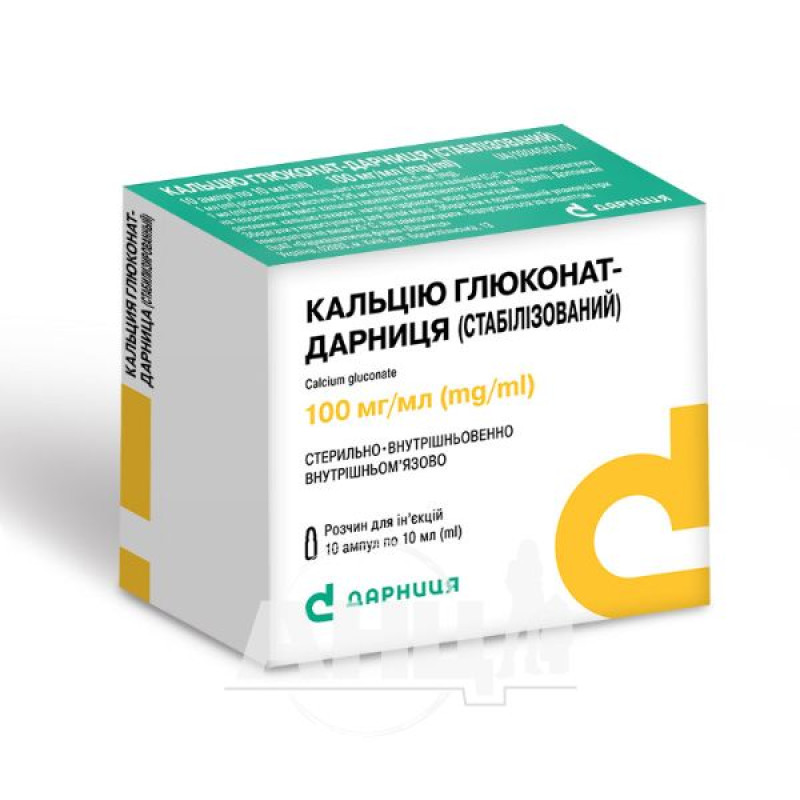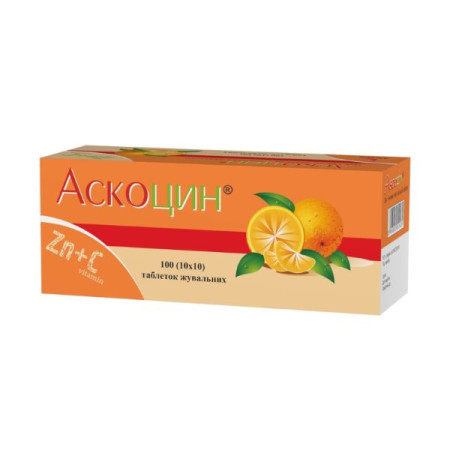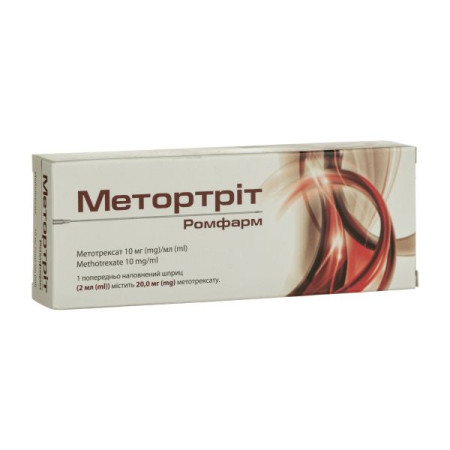Calcium gluconate-Darnitsa stabilized solution for injection 100 mg/ml ampoule 10 ml No. 10

Pharmacological properties
Pharmacodynamics. Calcium gluconate (stabilized) is a drug that regulates metabolic processes, replenishes calcium deficiency in the body, has a hemostatic, antiallergic effect, and reduces capillary permeability.
Calcium ions are involved in the transmission of nerve impulses, the contraction of smooth and striated muscles, the functioning of the myocardium, and blood clotting; they are necessary for the formation of bone tissue and the functioning of other systems and organs. The concentration of calcium ions in the blood decreases in many pathological processes; severe hypocalcemia contributes to the occurrence of tetany. In addition to eliminating hypocalcemia, calcium compounds reduce vascular permeability, have anti-allergic, anti-inflammatory, and hemostatic effects.
Pharmacokinetics. After parenteral administration, the drug is evenly distributed in all tissues and organs. In blood plasma, calcium is in an ionized state. It passes through the placental barrier, is excreted in breast milk. It is excreted from the body mainly by the kidneys.
Indication
Insufficiency of parathyroid function; increased excretion of calcium from the body (especially with prolonged dehydration); as an adjuvant in allergic diseases (serum sickness, urticaria, angioedema) and allergic complications of drug therapy; to reduce vascular permeability in pathological processes of any origin (exudative phase of the inflammatory process, hemorrhagic vasculitis, radiation sickness); parenchymal hepatitis, toxic liver lesions, nephritis, eclampsia; hyperkalemia; hyperkalemic form of paroxysmal myoplegia; skin diseases (itching, eczema, psoriasis); as a hemostatic agent; as an antidote for poisoning with magnesium salts, oxalic acid or its soluble salts, soluble salts of hydrofluoric acid.
Application
It is applied intravenously or intramuscularly.
The ampoule with the solution is warmed to body temperature before administration. The solution is administered slowly, over 2-3 minutes.
Adults and children over 14 years of age are administered 5-10 ml of Calcium Gluconate-Darnitsa (stabilized) daily or every 1-2 days, depending on the course of the disease and the patient's condition.
Children are only administered intravenously, depending on age, 10% calcium gluconate solution in the following doses: under 6 months - 0.1-1 ml, 6-12 months - 1-1.5 ml, 1-3 years - 1.5-2 ml, 4-6 years - 2-2.5 ml, 7-14 years - 3-5 ml.
To administer a solution in an amount of less than 1 ml, a single dose is adjusted to the appropriate volume (syringe volume) with 0.9% sodium chloride solution or 5% glucose solution.
Contraindication
Hypersensitivity to the components of the drug; tendency to thrombosis; hypercalcemia; severe hypercalciuria; severe atherosclerosis; increased blood clotting; severe renal failure; sarcoidosis; simultaneous use with cardiac glycosides, ceftriaxone.
Side effects
With rapid administration, nausea, vomiting, increased sweating, a feeling of heaviness in the head, syncope, general weakness, arterial hypotension, vasomotor collapse, sometimes fatal. Sometimes diarrhea, bradycardia, a feeling of heat in the oral cavity, and then throughout the body, which quickly pass on their own, are possible; calcification of soft tissues due to extravasation of calcium solution. IM injections of calcium salts can cause irritation.
Very rarely, allergic and anaphylactic reactions, up to anaphylactic shock, are possible.
Special instructions
Calcium salts should be used with caution in patients with impaired kidney function and heart disease.
When used in patients receiving cardiac glycosides and/or diuretics, as well as during long-term treatment (especially in children), it is necessary to monitor the concentration of calcium and creatinine in the blood. In case of an increase in their concentration, the dose of the drug should be reduced or its use temporarily discontinued.
With caution and with regular monitoring of the level of urinary calcium excretion, it is prescribed to patients with moderate hypercalciuria exceeding 300 mg/day (7.5 mmol/day), not sharply expressed renal dysfunction, urolithiasis in history. If necessary, the dose of the drug should be reduced or canceled. Patients with a tendency to the formation of stones in the urinary tract are recommended to increase the amount of fluid consumed during treatment.
Before filling the syringe with a calcium gluconate solution, it is necessary to make sure that there are no residues of ethyl alcohol in it, since calcium gluconate precipitates due to interaction with alcohol.
Use during pregnancy and breastfeeding. The use of the drug during pregnancy and breastfeeding is possible taking into account the benefit to the mother / risk to the fetus (child).
Children. Children under 14 years of age are not recommended to administer the drug intramuscularly due to the possibility of necrosis.
Ability to influence the reaction rate when driving vehicles or working with other mechanisms. There is no data on the negative effect of the drug on the reaction rate when driving vehicles or working with other mechanisms.
Interactions
When ethyl alcohol interacts with calcium gluconate, the latter precipitates.
It is not recommended to prescribe it together with other calcium preparations.
Intravenous administration of calcium gluconate before and after taking verapamil reduces its hypotensive effect, but does not affect its antiarrhythmic effect.
When used simultaneously with quinidine, slowing of intraventricular conduction and increased toxicity of quinidine are possible.
During treatment with cardiac glycosides, parenteral administration of calcium gluconate is not recommended due to increased cardiotoxic effects.
Calcium gluconate eliminates the inhibition of neuromuscular transmission caused by the use of aminoglycoside antibiotics.
When used simultaneously with nifedipine, calcium preparations reduce its effectiveness.
Incompatibility. Pharmaceutically incompatible with ethyl alcohol, carbonates, salicylates, sulfates, tartrate.
Overdose
Symptoms: possible development of hypercalcemia. Symptoms of hypercalcemia may include anorexia, nausea, vomiting, constipation, abdominal pain, muscle weakness, polydipsia, polyuria, mental disorders, nephrocalcinosis, nephrolithiasis, in severe cases - arrhythmia and coma.
Treatment: in case of a slight overdose (calcium concentration in blood plasma - 2.6-2.9 mmol / l) the administration is stopped and other calcium drugs are canceled. In case of a severe overdose (calcium concentration in blood plasma 2.9 mmol / l) parenteral calcitonin at a dose of 5-10 IU / kg of body weight per day (diluting it in 500 ml of 0.9% sodium chloride solution), intravenously drip for 6 hours. It is possible to intravenously slowly inject 2-4 times a day. Non-thiazide diuretics are used, the concentration of potassium and magnesium in blood plasma is monitored, if necessary, potassium and magnesium preparations are administered; the functions of the cardiovascular system are monitored, β-adrenoceptor blockers are administered to prevent arrhythmias. If necessary, hemodialysis is performed.
Storage conditions
In the original packaging at a temperature not exceeding 25 °C. Do not freeze.
There are no reviews for this product.
There are no reviews for this product, be the first to leave your review.
No questions about this product, be the first and ask your question.







